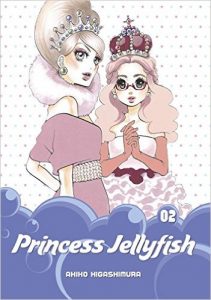By Akiko Higashimura. Released in Japan in two separate volumes as “Kuragehime” by Kodansha, serialization ongoing in the magazine Kiss. Released in North America by Kodansha Comics.
Princess Jellyfish is turning out to be a difficult but worthy read for me. I spent much of this omnibus being irritated by the majority of the characters, either for making stupid decisions, being horrible people, or having the self-awareness of a gnat. And of course, that’s what the whole point is. It’s where the majority of the comedy comes from, and also the character development. Without Tsukimi’s introvertedness and low self-esteem, without Inari’s blackmail and vampishness, and without Kuranosuke’s amazing unself-awareness (though he’s above the majority of Amars, to be sure), we wouldn’t have anything to read about. And all of these aspects are in this volume in abundance.
Tsukimi is our heroine, of course, and so she gains the most depth here, even as she takes a few steps back as well. I’m still not particularly happy with Kuranosuke’s constant attempts to get her to do things and be more outgoing, but it does lead to a few nice moments, particularly when they’re designing dresses based on types of jellyfish and Tsukimi unleashes her inner fashion designer. (I also appreciates the fact that, while she does have untapped talent, things weren’t perfect right off the bat and the first attempt was totally wrong.) Sadly, she alsp sees the guy she has a crush on with another woman, and has no idea how to deal with it, even as she’s unsure what her feelings are. She equates love as something that makes her a ‘normal girl’, something to be truly feared.
And while the residents of Amars may not be normal girls (though they show surprisingly more aptitude at attempting it than Tsukimi does), Kuranosuke and his family prove to be just as screwed up. Inari is trying to tempt Shu using sex as a weapon, but he’s repressed (as we discover here, he seems to have been traumatized by walking in on his father as a young boy) to a point where she’s actually thrown off her game. Inari is at her most interesting when she’s like this – the idea of Shu being a genuine innocent virgin almost horrifies her a bit – but I’m unsure how long the manga can keep this plot going. She certainly has staying power, I’ll grant you. As for Kuranosuke, he may be the most interesting character so far, even if I keep waffling between liking and disliking him. He’s amazingly selfish most of the time, and, just like Tsukimi, seems horrified at the idea of falling in love like a normal guy.
It’s the tension that keeps me going as a reader, seeing how far the author can take all these plot points – Kuranosuke’s secret that he’s actually a man, Inari being terrible, etc. – and actually have them collapse. And, of coruse, there’s the fashion design, which I suspect is going to take up more and more of this manga’s time. It’s not perfect, but it’s the flaws that make Princess Jellyfish so fascinating.


Speak Your Mind